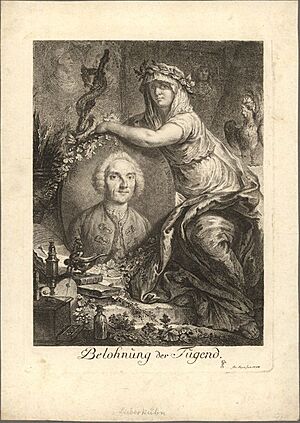Johann Nathanael Lieberkühn facts for kids
Johann Nathanael Lieberkühn (born September 5, 1711, in Berlin; died October 7, 1756, in Berlin) was an important German physician. His middle name is sometimes spelled Nathaniel instead of Nathanael. He made many discoveries about the human body and improved microscopes.
Lieberkühn first studied theology, which is the study of religion. Then, he became interested in physics, especially how things move and work (mechanics). After that, he began to study medicine.
In 1739, he traveled to Leiden in the Netherlands. A year later, he visited London and Paris. He then returned to Berlin. There, he joined the Collegium medico-chirurgicum. This group worked to make medical teaching and science better in the Holy Roman Empire. Lieberkühn also made mathematical and optical tools. He worked as a professor and a medical doctor.
Contents
Discoveries and Inventions
Lieberkühn was famous for preparing medical specimens. These were special samples of body parts used for study. His specimens were so well made that people still used them in the 1800s, especially in Moscow. He made them by injecting wax-like fluids into body parts. This helped the specimens keep their shape for a long time.
Crypts of Lieberkühn
A part of the human body is named after him: the Crypts of Lieberkühn. These are tiny glands found in the intestines. He was the first to describe them in great detail. He wrote about them in his book, De fabrica et actione vollorum intestinorum tenuium hominis, in 1745.
Improving Microscopes
Lieberkühn also created better optical tools. He improved the light microscope, which he first saw in Amsterdam. His special microscopes helped people study blood vessels. People at the time called these microscopes "Wundergläser," which means 'wonder-glasses.'
Recognition
In 1755, Lieberkühn was chosen as a foreign member of the Royal Swedish Academy of Sciences. This was a great honor, showing how important his work was.
See also
 In Spanish: Johann Nathanael Lieberkühn para niños
In Spanish: Johann Nathanael Lieberkühn para niños
- Crypts of Lieberkühn
Sources


